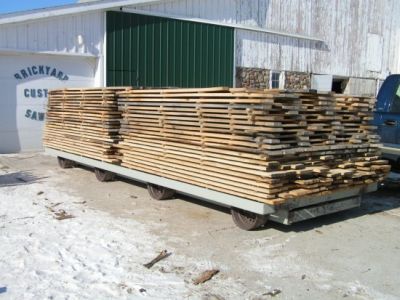Air drying:
Air drying is the process of drying the timber through exposing it to the air. The technique of air drying consists of making a stack of sawn timber separated by stickers, on raised foundations, in a cool, dry place. The rate that the wood is dries depends on the climate conditions and on air movement. For the wood to be dried successfully it has to be exposed to a continuous flow of air. The loss of moisture can be controlled by coating the planks of timber with a substance that is impermeable to moisture such as mineral oil.

Advantages – It can be less expensive to use this drying method and air drying often produces a higher quality of wood and the finished wood is more workable than the finished wood that comes out of kiln drying.
Disadvantages- Depending on the climate of the place you are drying the timber in, it takes several months up to a number of years to air dry the wood, and kiln drying can dry wood a lot quicker than this. Another disadvantage of air drying could be that the wood has to be put somewhere, which takes up space which could also cost some money for the company and that there is little to no control over the drying elements so drying degrade cannot be controlled. If air drying is done improperly and is exposed to sun, the rate of drying may be too quick and will cause the wood to crack and split, if it is done in winter, the opposite may happen and it may take too long to dry.
Kiln drying:
Kiln drying is done by introducing head to the wood. This can be done using natural gas or electricity, through steam heated machines. In this process you can control the temperature, the humidity and air circulation at various stages, the quality of the finished and dried wood that comes out of the kiln often depends on how you controlled each variable. In this machine the wood is stacked in chambers called wood drying kilns which each have equipment that helps it dry faster by increased air circulation and control of temperature. This process over comes the limitations introduced by the climate and weather conditions. In this process the timber can be dried to any moisture content, but in air drying, achieving a moisture content that is under 18% is difficult in most locations.


Advantages- Some advantages of kiln drying is that the temperatures that are introduced during kiln drying are above 60 C which kills of all the fungi and insects that are in the wood, this isn’t really guaranteed in air drying. Another advantage of kiln drying is that the time it takes to dry a load of timber is considerably less than that of air drying as the heat introduced during the process speeds it up rapidly. Also, in kiln drying you can control all of the variables such as moisture content, temperature and air circulation, so overall better control, you would not have much control over that in air drying.
Disadvantages – Depending on the species of wood you are trying to dry, overall is a lot more expensive than air drying, you also need to build the kiln or have it put in costing extra money. Also, as you can control the variables, some people may tune them at different levels and may dry the wood too quickly; this can also result in internal stresses such as splitting and warping.
No comments:
Post a Comment